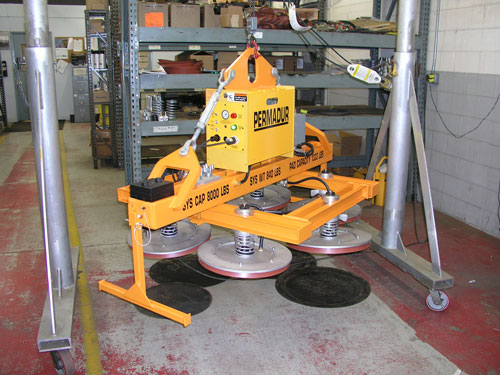Every day, you're faced with lifting decisions that go beyond just getting the job done—they directly impact safety, efficiency, and overall productivity. Selecting between large and small vacuum lifting systems isn't just about preference; it's about ensuring your equipment precisely fits your operational needs. Overestimating or underestimating your lifting system needs can quickly lead to compromised safety, slowed production lines, and a growing sense of frustration.
Navigating these choices can feel challenging, particularly when specifications overlap. Understanding precisely when and why you should choose large plate vacuum systems or small plate vacuum systems is essential. Clearly defining your requirements in terms of plate size, thickness, workflow dynamics, and flexibility helps remove guesswork, ensuring you select the right system from the start.
When Does a Large Plate Vacuum Lifting System Become Your Best Option?
You're already aware of how quickly production demands escalate when you're consistently handling expansive, oversized materials. When plate dimensions stretch to 8' x 20' or even up to 50', conventional lifting methods often become impractical and unsafe. Large plate vacuum lifting systems are engineered explicitly for substantial dimensions and weights, offering tailored capacity and stability.
Recognizing your operational demands
- Plate dimensions and thickness matter significantly: When your plate sizes regularly range from 8' x 20' to as large as 50' and thickness reaches up to 2", you need specialized power packs—like Permadur's 1500 and 3000 Power Pacs—capable of maintaining a uniform, stable vacuum across expansive surfaces.
- Complex handling requires flexibility: Large systems offer adjustable crossarms, repositionable pads, and rotating arms. If your workflow demands frequent adaptation to varying plate sizes and configurations, these features become critical.
- Safety and regulatory compliance are paramount: Large vacuum systems provide built-in features essential for compliance and safe operation.
- Audible low vacuum alarms instantly alert operators to potential issues.
- Backup vacuum reservoirs maintain grip in case of sudden power loss.
- Conformity with stringent ASME BTH-1, Design Category "B," and Service Class 2 regulations ensure rigorous safety standards.
Advantages unique to large vacuum systems
- High-capacity vacuum pumps: Handle substantial loads and rapid cycle times effectively.
- Comprehensive safety indicators: Integrated LED warning lights at multiple points along the load beam enhance visibility and confidence.
- Remote radio control compatibility: Offers operators flexibility, essential for expansive shop floors or crane-based operations.
Choosing a large plate vacuum system addresses your needs for lifting expansive, heavy, or unwieldy materials, greatly enhancing your overall operational control and efficiency.
Are Small Plate Vacuum Lifting Systems More Aligned with Your Needs?
You know firsthand that precision and maneuverability are crucial in operations involving smaller, thinner plates. These smaller dimensions (typically 4' x 8', 5' x 10', or 6' x 12') demand specialized systems explicitly designed for efficient, flexible, and agile handling. Choosing larger, overpowered systems here introduces unnecessary complexity, wasted energy, and lost productivity.
Identify when a small vacuum lifting system aligns precisely with your operational demands.
- Working with thinner, smaller plates: If your plates commonly range from gauge thickness to approximately 1", compact power packs like Permadur's 250 and 330 balance power and efficiency without overkill.
- Frequent maneuverability and space restrictions: Smaller vacuum lifting systems fit seamlessly within tighter production environments. Features like adjustable guide handles and structurally lightweight beams simplify positioning and repositioning during rapid production cycles.
- Specialized handling scenarios (upender/downender): Often, smaller plate applications require plates to shift quickly from horizontal to vertical positions. Small vacuum systems efficiently integrate specialized capabilities, such as built-in upender/downender functionality, directly into the lifting process.
Key practical benefits of small vacuum lifting systems
- Reduced operational footprint: Optimally sized for tight work areas or smaller workshops.
- Efficient power use: Smaller vacuum power packs consume less energy while maintaining high lifting performance.
- Quick adaptability: Easy-to-adjust crossarms and pad repositioning facilitate rapid shifts between varying plate sizes and dimensions.
In scenarios demanding agility, precise handling, and efficient workflow for smaller plates, small vacuum lifting systems represent your most effective solution.
Clearly Defining Your Choice: Practical Factors to Consider
When determining your ideal vacuum lifting system, evaluate these specific practical considerations.
Evaluate your typical load size and dimensions
- Large vacuum systems: Best for large, expansive plates (up to 50 feet) and heavier loads (up to 2" thickness).
- Small vacuum systems: Ideal for precise lifts involving plates up to 12 feet and thinner gauges (typically gauge thickness to about 1").
Consider the required flexibility and speed of adaptation
- Large systems: Provide repositionable arms and pads, perfect for variable, high-capacity operations.
- Small systems: Offer easy repositioning, compact footprints, and quick operational adjustments, making them ideal for rapid workflow shifts.
Assess operational and safety compliance demands
- Both large and small systems maintain strict adherence to ASME BTH-1 safety standards.
- Large systems incorporate additional visible and audible safety warnings due to their higher load capacities and associated risks.
Summary of Key Application Scenarios
Choose Large Plate Vacuum Lifting Systems if:
- You regularly handle expansive plates (8' x 20' to 50').
- Plate thicknesses consistently approach 2".
- You require robust safety features, adjustable configurations, and high-capacity vacuum reserves.
Choose Small Plate Vacuum Lifting Systems if:
- You consistently handle smaller plates (4' x 8', 5' x 10', 6' x 12').
- You work within space-restricted environments or require quick adaptability.
- Your plates require agile maneuverability or specialized movements (e.g., vertical or horizontal repositioning).
Take the Guesswork Out of Your Vacuum Lifting Decisions
Understanding precisely which vacuum lifting system—large or small—is best suited for your unique operational demands ensures reliability, enhances safety, and significantly improves your overall productivity. By clearly defining your typical load requirements, workspace dynamics, and safety priorities, you gain clarity and confidence in your equipment selection.
If questions remain or if specific scenarios require more detailed consideration, Permadur's knowledgeable team is always available to help guide you to a precise and practical vacuum lifting solution tailored precisely to your operational needs.


